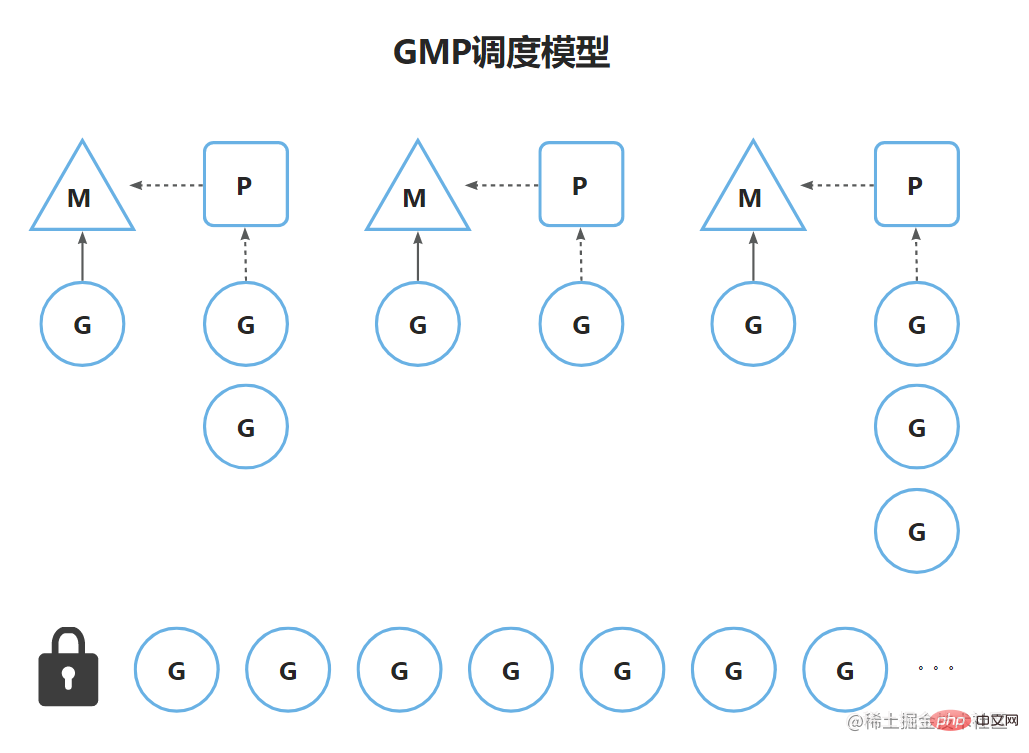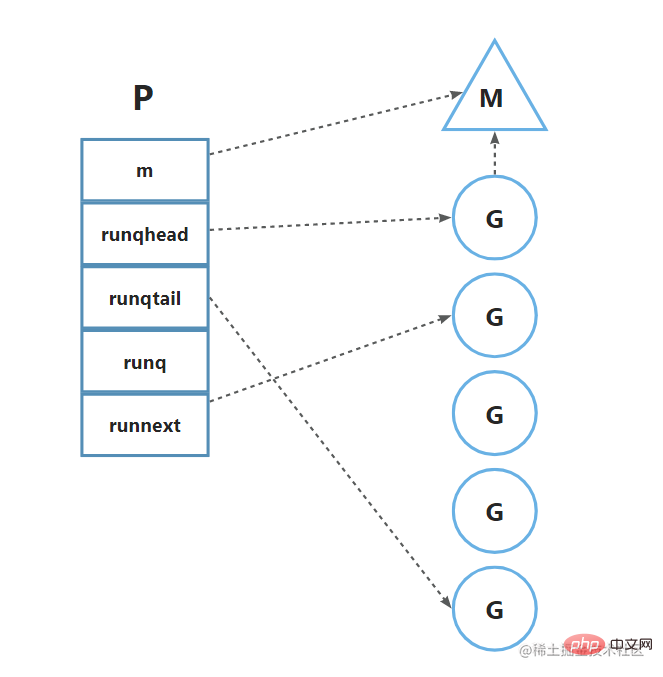深入淺析Go語言中要有GMP調度模型的原因
- 青灯夜游轉載
- 2023-04-14 15:26:342163瀏覽
Go為什麼要有GMP調度模型?以下這篇文章跟大家介紹一下Go語言中要有GMP調度模型的原因,希望對大家有幫助!

GMP調度模型是Go的精髓所在,它合理地解決了多執行緒並發調度協程的效率問題。
GMP是什麼
首先得清楚,GMP各代指什麼東西。
- G: Goroutine的縮寫,指協程,運行在執行緒上。
- M: Machine的縮寫,即thead,線程,循環的調度協程並執行。
- P: Processor的縮寫,指處理器,將協程儲存到本機佇列,並為執行緒提供未休眠的可用的協程,

處理器P
協程G和執行緒M結構在前幾篇已經講解了,這裡解析一下處理器P。作用
處理器P儲存一批協程,使得執行緒M可以無鎖定的從中取得協程,而無需與其他執行緒去競爭全域佇列中的協程,從而提高調度協程效率。原始碼解析
p結構體原始碼在src\runtime\runtime2.go中,這裡展示部分重要欄位。
type p struct {
...
m muintptr // back-link to associated m (nil if idle)
// Queue of runnable goroutines. Accessed without lock.
runqhead uint32
runqtail uint32
runq [256]guintptr
runnext guintptr
...
}
- m
為處理器p所屬的執行緒 - runq
是儲存協程的佇列 - runqhead
,runqtail表示佇列的頭尾指標 - runnext
指向下一個可執行的協程

線程M與處理器P是如何協作的?
在src\runtime\proc.go中,有一個schedule方法,這是執行緒運行的第一個函數。這函數中,執行緒需要取得到可運行的協程,程式碼如下:
func schedule() {
...
// 寻找一个可运行的协程
gp, inheritTime, tryWakeP := findRunnable()
...
}func findRunnable() (gp *g, inheritTime, tryWakeP bool) {
// 从本地队列中获取协程
if gp, inheritTime := runqget(pp); gp != nil {
return gp, inheritTime, false
}
// 本地队列拿不到则从全局队列中获取协程
if sched.runqsize != 0 {
lock(&sched.lock)
gp := globrunqget(pp, 0)
unlock(&sched.lock)
if gp != nil {
return gp, false, false
}
}
}從本地佇列中取得協程func runqget(pp *p) (gp *g, inheritTime bool) {
next := pp.runnext // 队列中下一个可运行的协程
if next != 0 && pp.runnext.cas(next, 0) {
return next.ptr(), true
}
...
}那麼如果本地佇列和全域佇列中都沒有協程了怎麼辦呢,難道就讓線程這麼閒著? 這時候處理器P就會任務竊取,從其他執行緒的本地佇列中竊取一些任務,美其名曰分擔其他執行緒的壓力,也提高了自己執行緒的使用率。 原始碼在src\runtime\proc.go\stealWork中,感興趣可以看看。
新建的協程該分配到哪?
新建的協程該分配到本地還是全域佇列呢,得分情況:- Go認為新協程的優先權高,於是先找本地佇列放入,而且還插隊。
- 本隊佇列滿了才放入全域佇列。
- 隨機尋找P
- 將新協程放入P的
- runnext
中,意味著下一個就運行該協程,插隊了若P的協程滿了,則放入全域佇列
src\runtime\proc.go \newproc函數中。
// Create a new g running fn.
// Put it on the queue of g's waiting to run.
// The compiler turns a go statement into a call to this.
func newproc(fn *funcval) {
gp := getg()
pc := getcallerpc()
systemstack(func() {
newg := newproc1(fn, gp, pc) // 创建新协程
pp := getg().m.p.ptr()
runqput(pp, newg, true) // 寻找本地队列放入
if mainStarted {
wakep()
}
})
}
結語
本篇初步介紹了GMP調度模型,具體介紹了處理器P以及執行緒M取得協程的方式。 處理器P解決了多執行緒互斥取得協程的問題,提高調度協程的效率,但是不管協程在本地還是全域佇列,目前看來還只是順序執行,那Go是如何實現協程異步並發執行的呢?咱下一篇繼續分析(雖然沒什麼人看...)。 推薦學習:以上是深入淺析Go語言中要有GMP調度模型的原因的詳細內容。更多資訊請關注PHP中文網其他相關文章!
陳述:
本文轉載於:juejin.cn。如有侵權,請聯絡admin@php.cn刪除
上一篇:如何在Go中進行Post請求下一篇:如何在Go中進行Post請求

